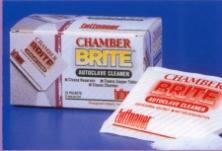Tuttnauer Chamber Brite MSDS Sheet T-754

Revised
12/01/2001
SECTION 1 - IDENTITY
Common
name (used on label) = Chamber Brite
(Trade name & synonyms) = Chamber
Brite- autoclave cleaner- acidic descaler
Chemical
family = Acidic salts
SECTION
2 - INGREDIENTS
Components-hazardous
CAS No. Threshold limit value
(Or other hazard data)
Sodium
Gluconate 527-07-1 LD50>1000mg/kg
Citric acid 0077-92-9 LD50>1000mg/kg
Poly ethylene oxid alcohol 28027-38-3 LD50>2000mg/kg
SECTION
3 - PHYSICAL DATA
Boiling
point/range: N/A Melting point: N/A Specific gravity: (H20 = 1)
Vapor pressure
(MM HG): N/A Vapor density (Air = 1): N/A Solubility in H20: complete
Appearance
and odor: Salts Mixture
ph:
(0.5%): 2.2
SECTION
4 - FIRE EXPLOSION HAZARD
Flash
point: Flammable limits: Auto ignition temp.
Lower: N/A Upper: N/A N/A
Extinguishing
media: Water- Water- Water-
Spray Fog Stream
SECTION
5 - HEALTH HAZARDS
Permissible
exposure limits:
No exposure limit has been established for this mixture.
Emergency
first air procedures:
Ingestion
(if swallowed):
DO NOT induce vomiting - give plenty of water or milk - get
medical attention.
Dermal:
Wash with soap and water - get medical attention.
Eye
contact:
Flush with plenty of water for at least 15 minutes - get medical
attention.
If in eyes, immediately flush eyes with plenty of water for at
least 15 minutes. Hold eyelid open while flushing.
Inhalation:
Remove to fresh air.
SECTION
6 - REACTIVITY DATA
Stability:
Stable Conditions contributing to instability: N/A
Hazard
rating (NFPA 704M): Extreme high4 high3 moderate2 slight 1 least 0
Health(blue)
Flammability(red)0 Reactivity (yellow) 0
Incompatibility - AVOID contact with Strong alkalis, stron oxidizers.
Hazardous
decomposition thermal and other:
Thermal: oxidis of carbon.
Conditions
to avoid: see above.
SECTION
7 - TOXICITY DATA
Route:
N/E Oral: N/E Dermal: N/E Inhalatio N/E
Toxic
effects/routes of entry
Eye
effects/routes of entry
Eye
effect: corrosive
Overexpossure will cause extreme burns that may result in permanent damage to
the eyes. Exposure to low level concentrations may cause moderate irritation or
conjunctivitis.
Skin
effect: irritant
Contact with skin may cause moderate to severe irritation. This product tends
to remove skin oils, possibly leading to irritation and dermatitis.
Other
toxic effects:
This product does not contain any components listed by LARC, NTP or OSHA as carcinogens.
Target
organ toxic:
This product may cause irritation to eyes and skin.
Toxicity
comments: N/E
SECTION
8 - SPILL OR LEAK PROCEDURES
Flush with water Absorb with sand or inert material Neutralize Prevent spread
or spill
Spill
or release procedure:
1) Confine spill.
2) Stop leak at source if this can be done safely.
3)
Be sure area is well ventilated.
4) Transfer material into drums for disposal.
5) Wash area with water.
6) Residual amounts should be flushed to chemical
waste treatment.
Absorb
with non-combustible material and place residue in DOT approved waste containers.
KEEP OUT of sewers, storm drains and surface waters.
Consult
federal, state or local authorities for proper disposal procedures.
SECTION
9 - SPECIAL PROTECTION INFORMATION
Ventilation
requirements: local exhaust
Eye:
safety goggles
Eye
protection: where there is potential for eye contact, wear chemical goggles and
have eye flush equipment immediately available.
Hand
(glove type): Any non-permeable to product. Liquid-proof rubber or neoprene
gloves are recommended.
Respirator
type: Cartridge
Filters
Mist
Respiratory
protection: Avoid breathing mist/dust. Use NIOSH/MSHA approved repiratory protection
appropriate to the components, when air exposure limits are exceeded, consult
respirator manufacturer to determine appropriate type of equipment. Observe use
limitations specified by NIOSH/MSHA or the manufacturer. For emergency and other
conditions where exposure limits may be significally exceeded, use an approved
full face, positive pressure, self-contained breathing apparatus or positive pressure
airline with auxiliary self-contained air supply. Respiratory protection must
comply with 29CFR.1910.134
Other
protective equipment: Apron
Click here if you need a copy of the safety date sheet for Chamber Brite